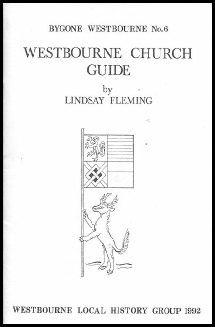
WESTBOURNE
A village history in West Sussex
PUBLICATIONS
Westbourne History Group
Bygone Series
No2. Village Schools 1819-
No9. The Bastards of Westbourne
No10. Westbourne’s War 1939-
No15. The Village Schools 1810-
No16. Westbourne and the Great War
No17. Tradespeople of Westbourne
Numbers 1 to 5 inclusive out of print, further information on details and costs visit:
www.westbournevillage.org
Home | Personal | Church | Scouts | Schools | Ambrose | Sketchbook | Workhouse | Census | Memories | Yesteryear | Publications | Village Website
 I. THE PARISH
I. THE PARISH
The civil parish of Westbourne, or Bourne, is on the south-
The patronage of the Rectory of Westbourne was attached to the manor until 1829, thus belonging formerly to the Earls of Arundel. In recent years the advowson has had different owners. The present patron is the Bishop of Chichester.
II. THE CHURCH’S ORIGIN AND GROWTH
This Parish Church is dedicated to St. John Baptist, and his Beheading, 29th August, is observed as the festival. The church is prominently situated in the ancient township of Westbourne (Plates I and II). The evidence of Domesday Book, 1086, for a Saxon or Norman foundation is inconclusive. In the description of the place given therein, no church is mentioned; though in the adjoining parish, Warblington, Hampshire, then linked with the manor of Westbourne, were two churches, and it is possible that one of these was on the site of Westbourne church, if the boundary between the two parishes then followed a different line.
During the restoration of the church, about 1865, the Rev. John Hanson Sperling claimed ‘that he saw below the present flooring large square bases of early Norman pillars’, on which the later pillars had been built. The irregular spacing of these suggests that there may originally have been a Norman aisleless nave.
The stages in the church’s evolution, of which there is evidence to-
Early in the 16th century, again, it seems likely, by inspiration of an Earl of Arundel (William FitzAlan, 11th Earl of Arundel, c. 1476-
Published 1992 ISBN 0 9507496 5 6
WESTBOURNE CHURCH GUIDE